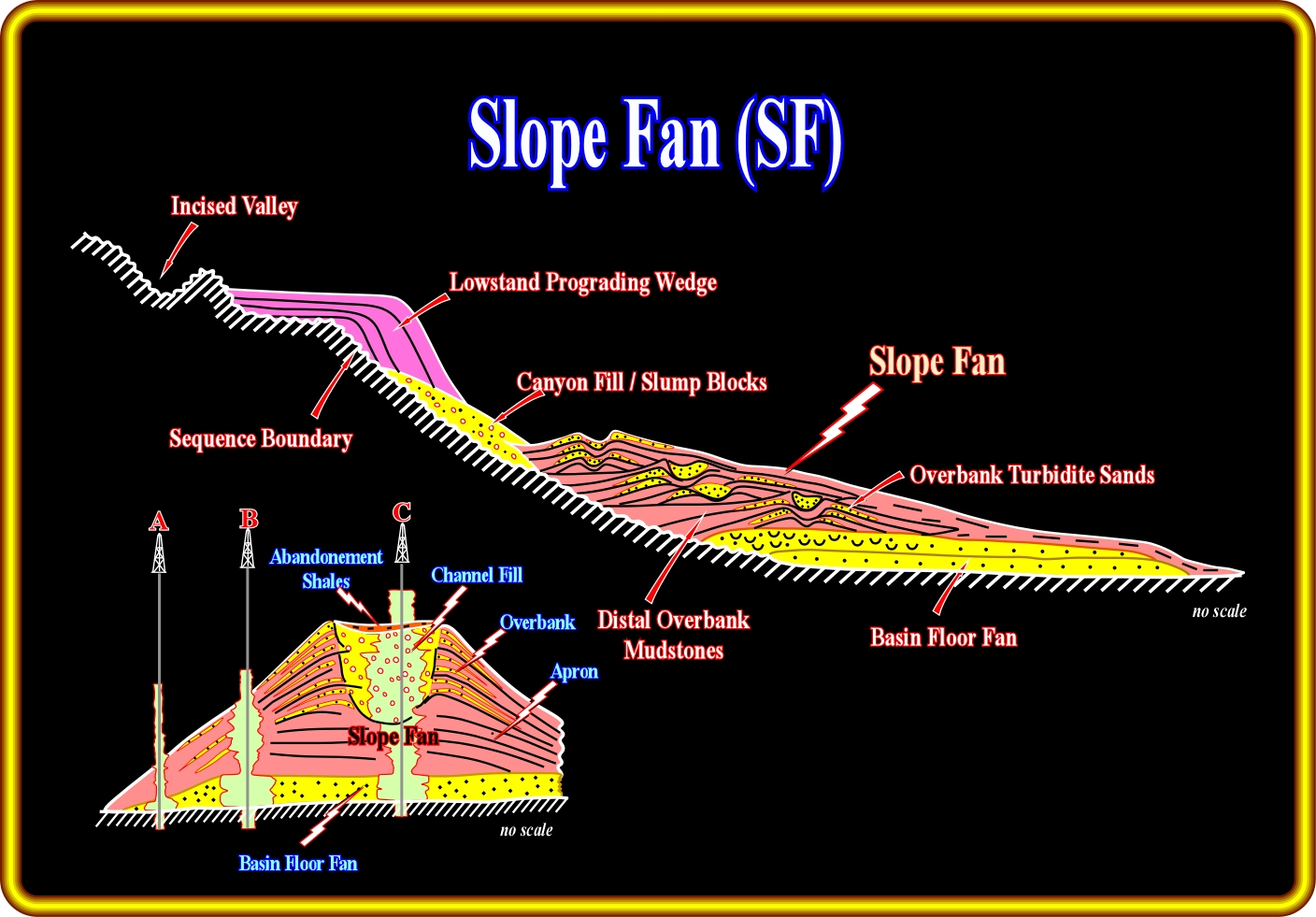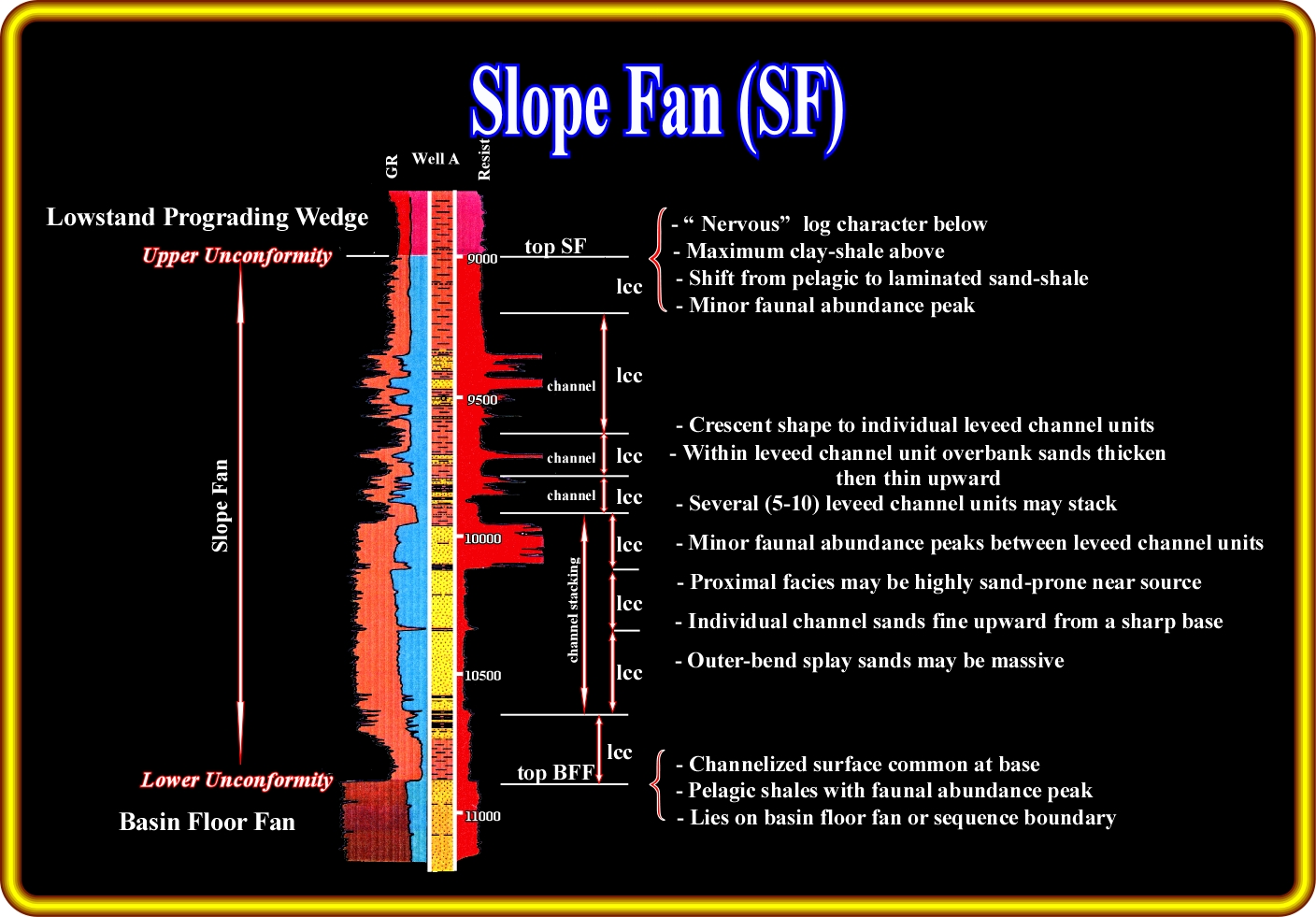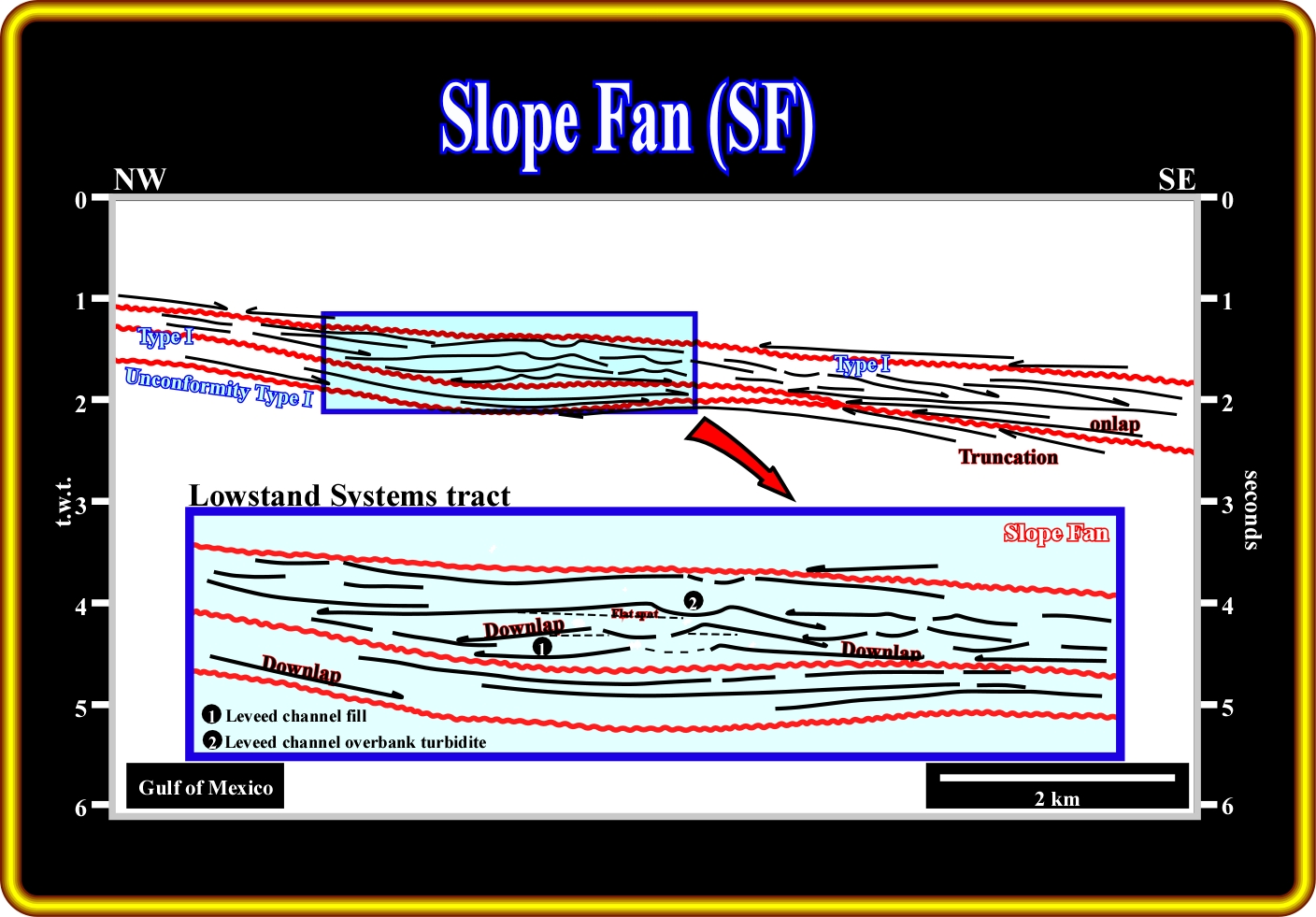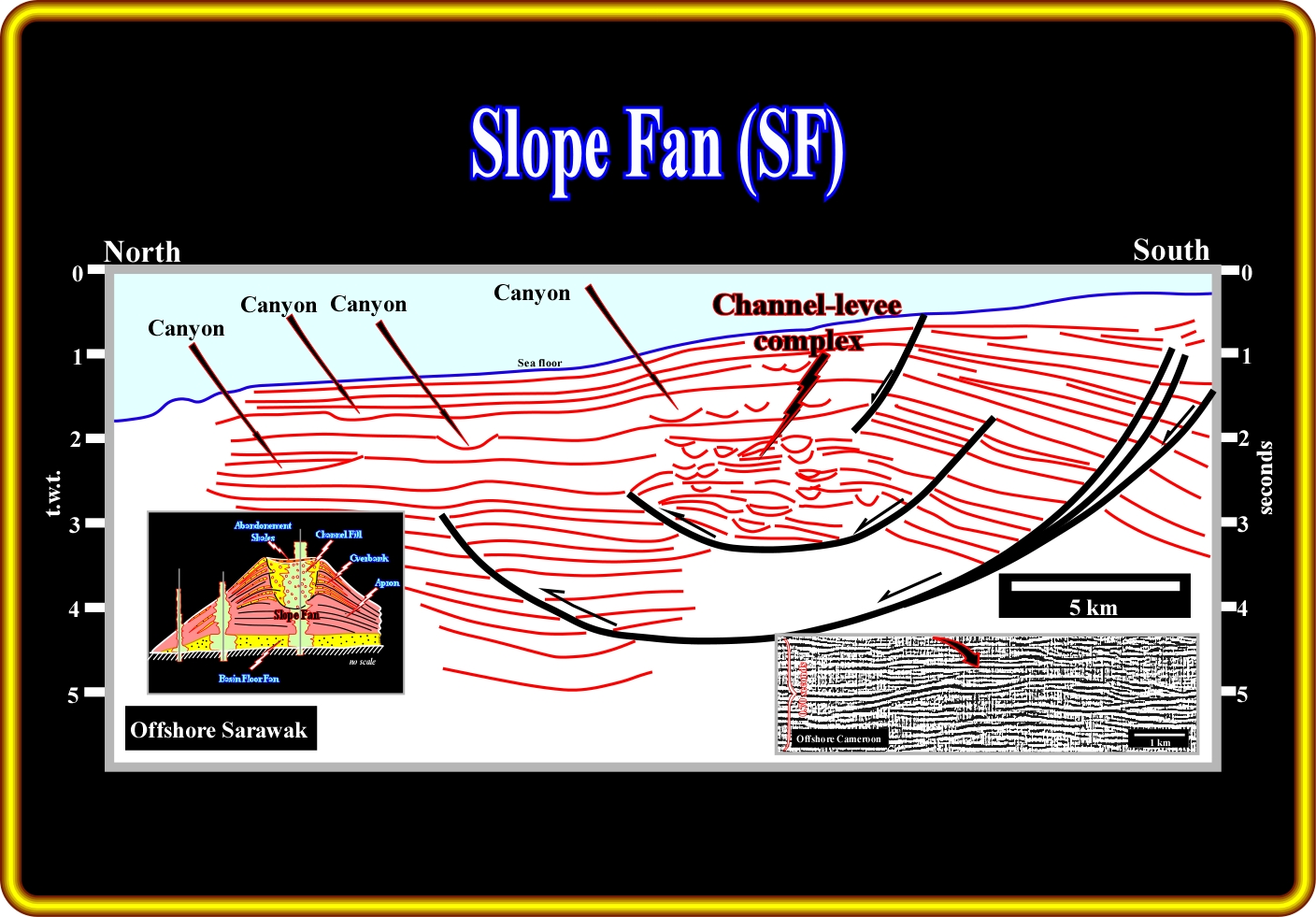.jpg)
The time of slope fan deposition is a time of major headward erosion and bank collapse of the submarine canyons. Actually, basin subsidence begins to create a very slow rise in the position of the sea level relative to the basin margin, as the rate of eustatic sea level fall slows and approaches zero at the lowest part of the eustatic cycle.
Seismic expression of the slope fan (see plates below) varies widely :
a) Externally, the fan appears as a broad thick apron of sediments with the thickest and crestal position linked to the source supply, often a submarine canyon ;
b) Internally, recognizable seismic facies patterns include slumped deposits from delta and adjacent flanks, the typical “gull wing” pattern of submarine channels and a discontinuous pattern associated with overbank sands near the crest of the slope fan.
Submarine channel sands make excellent exploration targets, particularly if they are identifiable seismically due to gas saturation. Overbank sands are thin, often below the resolution of the conventional logging tools, but their porosity and permeability may be startling high. Overbank sands are apparently created when the supply to a submarine channel exceeds the transport capacity of that conduit and sands well up over the levee and are widely spread in a thin sheet over the slope fan apron. Overbank sands appear to trap against the levee facies, or channel fill shales (clay-plug). In thick accumulations overbank sands may form a very large stratigraphic trap composed of many thin sands. A high level of petrophysical and well testing technology is needed to recognize and properly evaluate such a trap.

This geological model (modified from Vail, 1989) summarizes the chief characteristics of a lowstand systems tract (LST) and particularly those of a slope fan (SF), in which channel levee complexes are paramount. In a slope fan, reservoir predictions require a good understanding of the depositional model of channel levees. The main reservoir rocks are localized in the channel fills (infilling of the channels). The reservoirs in the overbank deposits are quite thin but widespread. When slope fans are the main reservoir intervals, geoscientists must employ very good seismic data, if possible 3D, in order to predict the most likely location of channel fills, where the thickness and lateral coalescence of the reservoir-rocks is large enough to trap economic amounts of hydrocarbons.

The picking of seismic reflectors of a seismic line from the offshore Indus illustrates the strike geometry of channel-levee complexes, which are the principal depositional systems of a slope fan where potential siliciclastic reservoir-rocks can be found. However, outwardly, the presence of sandstone reservoir depends exclusively on the lithologic composition of the turbiditic currents. In this particular area, the channel-levee complexes are shaleprone. In fact, taking into account the geological setting of the shelf and nearby onshore, it is quite logical to assume that the potential turbidite currents will be mainly composed by shaly sediments. Actually, the absence of differential compaction, particular above the channel fills (filling of the central conduits) strongly suggests a predominant shaly facies.
On electrical logs (SP, Gamma ray, Resistivity, Sonic, etc.), slope fans exhibit a typical cylindrical pattern as illustrated in the plate below, that is to say, a cylindrical and abrupt boundary in the sandprone channel (quite similar to a basin floor) and "nervous" log character in the overbank complexes, which underlies an alternation of upward thickening and thinning stratigraphic intervals (turbiditic levees).

These electrical logs, from a North Sea exploration well, summarizes the main characteristics of the log patterns of slope fans. A channel fill and, particularly, a stacking of channel fills may be underlined in a gamma ray or SP log by a blocky shape with a particularly sharp upper boundary. On the contrary, channel levee complexes, often, induce a typical nervous log response. Stacking of channel fills, when overlying a basin floor fan, are, often, difficult to recognize on electrical logs particularly when the apron shales, which generally are at the base of a slope fan, are absent.

In Gulf of Mexico, geoscientists working in petroleum exploration, are often looking for slope fans, particularly, channel levee complexes, as potential hydrocarbon reservoirs. In the majority of cases, they identify these potential reservoirs, when seismic anomalies, as bright spots or flat spots,are present due an hydrocarbon saturation. However, they forget that only a detailed sequential stratigraphy of the seismic lines and calibration of wells allows the prediction of the actual geometry of such reservoirs and their fluid content. The geometric relationships between the chronostratigraphic lines, i.e., the reflection terminations and seismic surfaces, between 1 and 2.5 seconds of a seismic line from Gulf of Mexico are depicted above. Three sequence-cycle boundaries, associated updip with type I unconformities, limit the lowstand systems tracts of two sequence-cycles. The upper one is mainly composed of the middle lowstand member (slope fan), in which channel-levee complexes are predominant. In terms of potential hydrocarbon reservoirs, one can say they are most likely thin sandstone layers of the overbank deposits, since the morphology of the central conduit suggests a shaly fill.
As said previously, slope fans have a substantial petroleum interest not only as potential reservoirs but as potential morphological and stratigraphic traps as well.
Their exploration applications can be summarized as follows:
(a) RESERVOIR
- 5-40 meters sands in channels ;
- Channel sands discontinuous ;
- Thin (1-300 cm) sands in overbank facie ;
- Overbank sands may be quite widespread ;
- Overbank sands difficult to recognize and evaluate.(b) MIGRATION
- Uncertain, probably vertical via fault conduits or from BFF.
(c) SOURCE
- Uncertain, probably deep.
(d) TRAP
- Typically stratigraphic ;
- Some structural enhanced.(e) SEAL
- Interval shale seals ;
- Top seal: condensed section ;
- Overbank sands limited by levees and apron-edge pinchouts.

On this preliminary geological tentative interpretation of a seismic line from Malaysia offshore, a thick slope fan was deposited in association with a listric fault (normal updip, reverse downdip). Channel levee complexes are easily recognized by the typical "gull wing" morphology induced by the overbank deposits, in which opposite downlap relationships are readily distinguished. In the lower right corner, is illustrated a detail of a seismic line from the Cameroon conventional offshore in which the geometry of a channel levee complex (gull wings of P. Vail) is easily recognized.
In the upper close-up are illustrated the main reservoir interval of a major oil field in the North Sea, in which slope fan sandstone reservoirs are paramount. Admittedly, in this kind of seismic data, it is quite evident that the knowledge of the different depositional models precedes the interpretation (“Theory Precedes Observation”). In other words, in this particular example, if the seismic interpreter does not know, a priori, the different depositional models of the lowstand systems tract, he can not understand the migration / entrapment petroleum subsystem, and so, the petroleum system itself. On the contrary, if he knows and understands the depositional systems of the lowstand systems tract, he can propose a tentative interpretation as illustrated above. In fact, knowing a priori the depositional model of the slope fan member of a lowstand systems tract, he can readily recognize, the reflections terminations, the seismic surfaces and the most likely location of the potential reservoirs : (i) The lower sequence boundary, which corresponds updip to an unconformity, can be easily picked ; (ii) The opposite downlap of the levees become evident, as well as (iii) The channel fills, i.e., the filling of the central conduits, which were the pathway of the turbiditic currents. So, taking into account this tentative interpretation, one can say that the main reservoirs of the field are the sandstones filling the original depression between the overbanks of a slope fan (in this context, the term channel can be misleading). On this subject, it is crucial to notice the mounded morphology of the top of the infilling, which when explained by differential compaction implies a sand facies. In the lower close-up, again, the a priori knowledge of the depositional systems composing the lowstand tract is a sine qua non condition to perform a coherent geological tentative interpretation. Junior geoscientists should not think that an increasing seismic quality or 3D data, can replace geological knowledge. Actually, it is the opposite, i.e., an increasing in quality and definition of the data requires a higher geological knowledge of the seismic interpreter. If not it is like give a Ferrari to a guy who does not know how to drive a car and does have a drive license. Briefly speaking, knowing the depositional models, taught in all Geological Schools, and the regional context of the area, the lower close-up can be easily interpreted as depicted.
Send E-mail to carloscramez@gmail.com with critics, corrections or commentaries on these Turbidite Deposits notes.
Copyright © 2001CCramez
Last modification : November, 2013